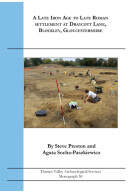An Iron Age Round House and Roman Villa at Chilton Fields, Oxfordshire (Paperback)
Imprint: Thames Valley Archaeological Services
Series: TVAS Monograph Series
Pages: 104
ISBN: 9780992633073
Published: 7th July 2015
Script Academic & Professional
Series: TVAS Monograph Series
Pages: 104
ISBN: 9780992633073
Published: 7th July 2015
Script Academic & Professional
Usually available in 6-8 weeks.
You'll be £20.00 closer to your next £10.00 credit when you purchase An Iron Age Round House and Roman Villa at Chilton Fields, Oxfordshire. What's this?
+£4.99 UK Delivery or free UK delivery if order is over £40
(click here for international delivery rates)
Order within the next 11 hours, 2 minutes to get your order processed the next working day!
Need a currency converter? Check XE.com for live rates
(click here for international delivery rates)
Order within the next 11 hours, 2 minutes to get your order processed the next working day!
Need a currency converter? Check XE.com for live rates
This report documents an area excavation covering some 2ha which was undertaken on the lower chalk plain north of the Berkshire Downs, now in south Oxfordshire. The excavations have revealed the full ground plan of a modest Roman villa along with a significant proportion of surrounding landscape features. Use of the site for a villa complex was preceded by a small amount of Bronze Age pit digging followed by a Middle Iron Age round house dating from 382-204 Cal BC, coincidentally located beneath the later villa. Four burials are also attributed to this Iron Age phase of use. After a clear break in the sequence of occupation, a stone-footed building was constructed in the later 2nd century AD and was subsequently modified and extended including construction of a veranda, into the 4th century AD. Ancillary structures include a well, a bathhouse, corn driers, and various other post-built structures as well as paddocks and enclosures beyond.
The building had gone out of use by the end of the 4th century AD but occupation may have continued with little or no break into Saxon times. No artefacts certainly of early Saxon date were recovered but two structures were typical of sunken floored buildings and pottery recovered from them included the latest 4th century types. The site was abandoned and forgotten from early in the Saxon period, presumably reverting back to agricultural use. The final activity on the site took place in the early post-medieval period with the digging of a small number of pits and the construction of a metalled trackway.
Other titles in the series...
Other titles in Thames Valley Archaeological Services...










